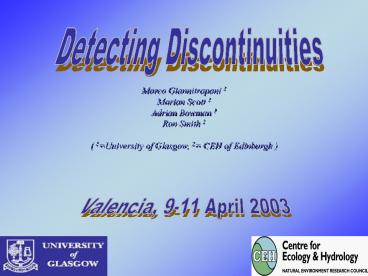Marco Giannitrapani 1 - PowerPoint PPT Presentation
1 / 34
Title:
Marco Giannitrapani 1
Description:
Marco Giannitrapani 1. Marian Scott 1. Adrian Bowman 1. Ron Smith 2 ... It is necessary to identify any discontinuities to understand the cause of the change: ... – PowerPoint PPT presentation
Number of Views:54
Avg rating:3.0/5.0
Title: Marco Giannitrapani 1
1
Detecting Discontinuities
Marco Giannitrapani 1 Marian Scott 1 Adrian
Bowman 1 Ron Smith 2 ( 1University of Glasgow,
2 CEH of Edinburgh )
Valencia, 9-11 April 2003
2
What is a discontinuity?
A discontinuity is an abrupt-change in mean
level.
Temporary change
Permanent change
Why are we interested in detecting
discontinuities?
- It is necessary to identify any discontinuities
to understand the cause of the change - Emission changes.
- Change in laboratory.
- Weather effects.
- Something else.
- If possible, it is so necessary to correct the
series before doing any trend analysis, if not,
to analyse each sub-trend separately.
3
DATA ANALYSED
- Weekly means of the natural logarithm of the
daily data for - SO2
- SO4 in air
- SO4 in precipitation (corrected and not for the
sea-salt) - Across Europe
4
Austria (4) Croatia (2) Czech Republic
(2) Denmark (6) Finland (7) France (12) Germany
(19) Latvia (2) Lithuania (2) Netherlands
(7) Norway (12) Poland (5) Slovakia (4) Sweden
(8) Switzerland (5) United Kingdom (10)
5
PRELIMINARY ANALYSIS
Daily data have shown the presence of two kind of
seasonal cycles
Day within the week
Week within the year
Difference between week and weekend days.
Difference between seasons of the year.
de-seasonalised data
6
Theory of the Discontinuity Test
The test used was proposed by Bowman and Pope
(1997) At each data point x1, x2,, xn we
observe the data y1, y2,, yn where
yi g(xi)ei for i 1, ,n.
(where g is a smooth function) The test
statistic is based on the difference between the
left (gl(xi)) and the right (gr(xi)) smooths,
where
Left Smoother Right Smoother
where kh (the kernel smoother) is the normal
density function in z with mean xj and standard
deviation h I is the indicator function.
Criteria for detection is given by gl(xi) -
gr(xi) gt 3 standard errors.
7
Plot of SO2
First Example of Discontinuity
8
First Example of Discontinuity
9
Plot of SO2
First Example of Discontinuity
10
First Type of Discontinuity
First Example of Discontinuity
11
First Example of Discontinuity
12
First Example of Discontinuity
13
First Example of Discontinuity
14
First Example of Discontinuity
15
Plot of SO4 in precipitation not corrected
Second Type of Discontinuity
Second Example of Discontinuity
16
Second Type of Discontinuity
Second Example of Discontinuity
17
Plot of SO4 in precipitation not corrected
Second Type of Discontinuity
Second Example of Discontinuity
18
Plot of SO4 in precipitation not corrected
Second Type of Discontinuity
Second Example of Discontinuity
19
Plot of SO4 in precipitation not corrected
Second Type of Discontinuity
Second Example of Discontinuity
20
Plot of SO4 in precipitation not corrected
Second Type of Discontinuity
Second Example of Discontinuity
21
Plot of SO4 in precipitation not corrected
Second Type of Discontinuity
Second Example of Discontinuity
22
Plot of SO4 in precipitation not corrected
Second Type of Discontinuity
Second Example of Discontinuity
23
Plot of SO4 in precipitation not corrected
Second Type of Discontinuity
Second Example of Discontinuity
24
Plot of SO4 in precipitation not corrected
Third Type of Discontinuity
Third Example of Discontinuity
25
Third Type of Discontinuity
Third Example of Discontinuity
26
Plot of SO4 in precipitation not corrected
Third Type of Discontinuity
Third Example of Discontinuity
27
Plot of SO4 in precipitation not corrected
Third Type of Discontinuity
Third Example of Discontinuity
28
Plot of SO4 in precipitation not corrected
Third Type of Discontinuity
Third Example of Discontinuity
29
Plot of SO4 in precipitation not corrected
Third Type of Discontinuity
Third Example of Discontinuity
30
Plot of SO4 in precipitation not corrected
Third Type of Discontinuity
Third Example of Discontinuity
31
Plot of SO4 in precipitation not corrected
Third Type of Discontinuity
Third Example of Discontinuity
32
Plot of SO4 in precipitation not corrected
Third Type of Discontinuity
Third Example of Discontinuity
33
Final Remarks
- The test can be used to identify whether changes
in trend have occurred. - Once a discontinuity is detected, the series
should be corrected before interpreting the
trend, or doing any analysis. If it is not
possible to do any corrections, then it becomes
necessary, to treat each sub-trend separately. - This version of the test requires estimation of
the correlation and of the variance of the data.
These have been computed on the basis of the
weekly means after removing any trend and
seasonality. - Because of the edge bias in smoothers, fifty
"testing points" at the start and fifty at the
end of the series have been excluded.
34
Conclusions
- A slight steadily decreasing trend can be noted,
which seems more pronounced for SO2. - However, the rate of decrease is not constant
over the entire time period, and discontinuities
represent a common feature. - In particular, several temporary
discontinuities have been identified. - There are strong arguments for not fitting a
single (and simple) trend function. - Some data present still peculiar features that
need to be revisited.































